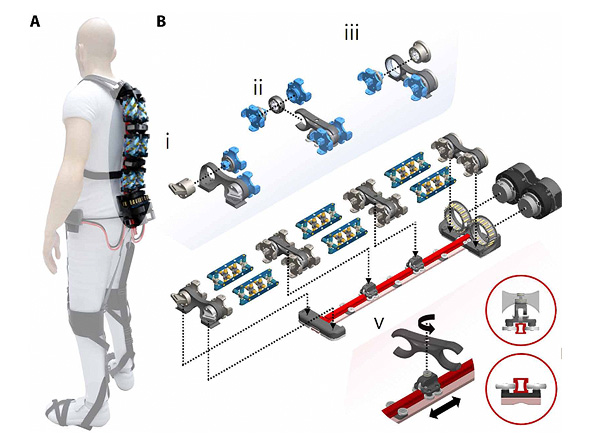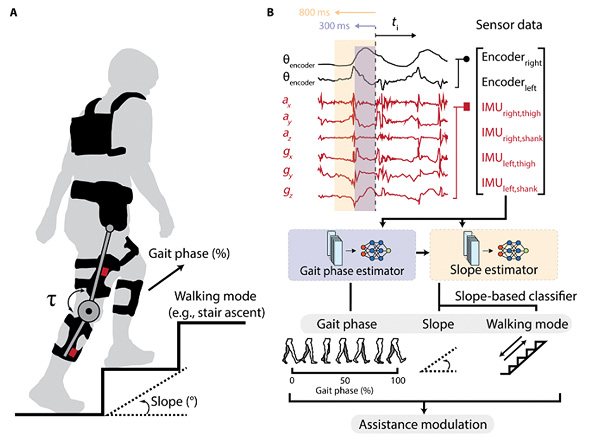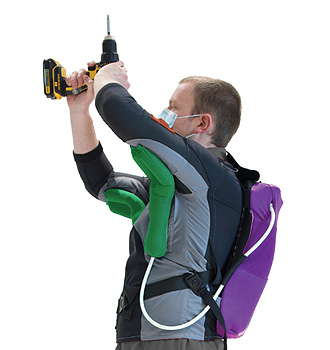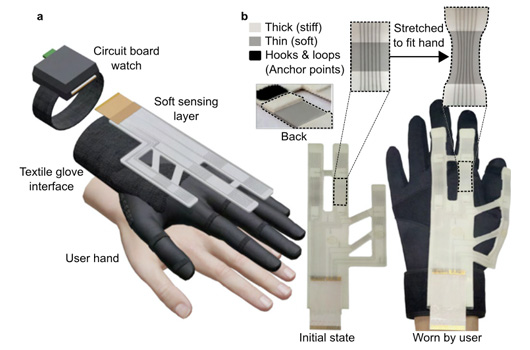Trends in Wearable Robotics Technology and Development
Introduction

Yong-Lae Park
Wearable robots are technologies that assist or augment human muscular strength and are widely used in rehabilitation therapy, industrial sites, and everyday life1). In particular, recently, rigidly structured exoskeleton robots and flexibly structured soft wearable robots have each advanced, thereby further improving user convenience and performance. In addition, as the distribution of commercialized wearable robots increases, actual cases of utilization in medical and industrial fields are also increasing. This article examines the technological trends of rigidly structured exoskeleton robots, soft wearable robots with flexible structures, and currently commercialized wearable robots.
Rigidly Structured Exoskeleton Robots
Exoskeleton robots are devices based on a rigid frame that assist or augment the user's muscular strength, and are mainly used in rehabilitation therapy and industrial settings. Traditional exoskeletons use rigid materials, which allow for high levels of strength augmentation or assistance, but they have the disadvantage of being relatively heavy and lacking flexibility. In recent studies, to overcome these limitations, technologies such as lightweight design, modularization, and artificial intelligence (AI)-based control have been introduced.
For example, a recently introduced modular exoskeleton system is designed to adjust the robot's configuration according to the user's movement and needs, so it can be optimized for various work environments and users (Figure 1). Through this, it can help specific occupational groups (e.g., logistics, manufacturing, etc.) to easily lift heavy objects, or provide customized support to prevent lower back muscle injuries caused by repetitive tasks. In rehabilitation therapy, support intensity can be adjusted according to the patient's stage of recovery2).
In addition, to improve the control performance of the exoskeleton, machine learning-based adaptive algorithms are being applied (Figure 2). In recent studies, technology has been developed that uses sensors to analyze the user's gait pattern and muscle signals in real time, and adjusts the assistive force accordingly. Such systems enable more natural and efficient walking assistance compared to traditional fixed-pattern control3).
As such, rigidly structured exoskeleton robots are gradually improving through lightweight and user-customized design, and are expected to be more actively utilized in various industrial and rehabilitation therapy environments in the future.


Soft Wearable Robots Using Flexible Materials
Soft wearable robots are devices that assist the user's movements by utilizing flexible materials, pneumatic systems, or smart materials. These robots are lighter than traditional exoskeleton robots, and focus on enhancing the wearer's comfort and safety by closely conforming to the human body. Recent studies have further improved the performance of soft wearable robots through artificial muscle technologies, sensor fusion, and customized adaptive control.
In a recently published study, a new type of artificial muscle was developed, introducing a technology that significantly enhances the actuation force of soft robots. This study proposed an actuator that provides high output while remaining lightweight, using an expandable flexible structure driven by pneumatic pressure (Figure 3). This technology can particularly contribute to reducing muscle fatigue in industrial workers who use their shoulder muscles repetitively.
Another study suggested methods to improve the sensor technology of soft robots to more accurately detect and respond to user movement. Recently developed ultra-thin flexible sensors can detect hand movements in real time based on the user's joint angles, and this enables remote control of the robot's natural movement (Figure 4).
As such, soft wearable robot technology is advancing in a direction that simultaneously enhances wearability and performance, and is expected to play an important role not only in rehabilitation therapy, but also in the sports and elderly assistive device markets in the future.


Current Technology Trends in Commercialized Wearable Robots
As the commercialization of wearable robots accelerates, actual products are being released in various fields. In particular, wearable robots for medical and rehabilitation purposes and industrial assistive wearable robots are being most actively developed, and the latest products combining AI and IoT technologies are emerging.
The domestic company WIROBOTICS has developed a wearable robot called WIM for elderly people who have difficulty walking due to muscle loss. This robot is worn on the waist and thighs to assist walking, and it features natural movement that aligns with the user's gait. It also includes a function that utilizes smart sensors to analyze walking patterns and provide customized assistance6).
In addition, the domestic wearable robotics company ANGEL ROBOTICS has developed the ANGEL LEGS M20 wearable robot for rehabilitation therapy, which is being used in medical settings. This robot is equipped with an AI-based gait analysis system that monitors the user's rehabilitation process in real time and guides them through optimized exercises. ANGEL LEGS obtained Class 3 medical device certification in 2022, and health insurance coverage is available, allowing actual patients to use it7).
As such, wearable robots are increasingly being commercialized, expanding opportunities for use by general consumers and in industrial sites, and are expected to further develop in the future by combining AI and data analytics technologies.
Conclusion
Wearable robot technologies are being developed separately into rigidly structured exoskeletons and soft wearable robots with flexible structures, and the number of commercialized products is also gradually increasing.
Recent studies identify important trends such as lightweight design and customized control in exoskeletons, high-performance artificial muscle and sensor technologies in soft wearable robots, and actual application cases in medical and industrial fields.
As wearable robot technologies continue to advance in the future, they are expected to contribute to improving the quality of human life.
Reference
- 1) The KEIT Technology Statistics Report for the 2nd week of February 2025, titled "Wearable Robots", was published by the Institute for Information & Communications Technology Planning & Evaluation (IITP) on February 11, 2025.
- 2) Kim et al., Bilateral Back Extensor Exosuit for multidimensional assistance and prevention of spinal injuries, Science Robotics, 9(92):eadk6717, 2024.
- 3) Lee et al., AI-driven universal lower-limb exoskeleton system for community ambulation, Science Advances, 10(51):eadq0288, 2024.
- 4) Zhou et al., A portable inflatable soft wearable robot to assist the shoulder during industrial work, Science Robotics, 9(91):eadi2377, 2024.
- 5) Park et al., Stretchable glove for accurate and robust hand pose reconstruction based on comprehensive motion data, Nature Communications, 15:5821, 2025.
- 6) "An Innovative Robot Helping Seniors with Muscle Loss Walk Again... Trying Out WeROBOTICS' 'WIM'", The Dong-A Ilbo, March 4, 2025.
- 7) "[K-Bio of the Month] Angel Robotics is leading the rapidly approaching era of AI humanoids", Bio Times, February 5, 2025.